
PREV ARTICLE
NEXT ARTICLE
FULL ISSUE
PREV FULL ISSUE
KAGIN’S MARCH 2018 ENCASED POSTAGE HIGHLIGHTSAs longtime E-Sylum readers know, one of my collecting specialties is U.S. Encased Postage stamps of the Civil War. Here is the press release with encased postage
highlights from the upcoming Kagin's auction at the American Numismatic Association’s National Money Show in Irving, Texas. -Editor
Kagin’s Auction to Offer Major Encased Postage Stamp Collection at ANA National Money Show in Irving, TX March 9 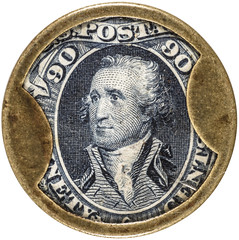 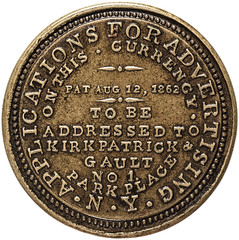 Kagin’s Auctions will be offering The Michigan Collection of encased postage stamps at the American Numismatic Association National Money Show in Irving (Dallas) Texas Friday March 9th. It is believed to be one of the most comprehensive sets ever and perhaps currently the finest and most complete including 147 different varieties. It is the result of some 25 years of working with Kagin’s Inc. attempting to fulfil a dream of acquiring all known varieties. The pedigrees include pieces from almost all the most complete and famous collections including Mayer, Kelly, Ford, Kagin and by extension, Wilcox, Dunham, Perl, Green and Lilly. Encased postage has always been one of the most historical and elusive of all numismatic and philatelic items to collect, and consequently one of the most rewarding to acquire. These coin substitutes helped augment the inadequate Federal coinage during our nation’s Civil War. In 1862 paper money was not backed by gold and silver and commerce was strained due to a shortage of coins which were being hoarded. Various attempts to alleviate the small change shortage included private companies issuing Civil War tokens, the government authorizing the use of postage stamps in trade, and business issuing promissory notes for change. Entering the fray was entrepreneur John Gault who patented the use of enclosing a U.S. stamp from 1c to 90c denominations with a round piece of brass. The stamp was sandwiched in between a roughly quarter sized piece of brass with a hole cut in it (the frame) followed by mica to protect the stamp, a piece of cardboard, and finally, a brass backing. A button making machine pressed these items together, the bent the edges of the brass frame over the edge of the brass back. Many of the cases of early examples were silvered to make them look closer to real coins. 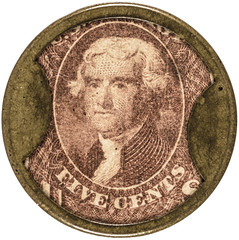 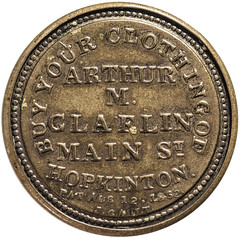 Gault sold the encased postage pieces to over 30 different merchants at about 20% over face value and another 2 cents each for stamping their advertising on the backs. Merchants and their products included J.C. Ayer & Company selling Sarsaparilla to “purify the blood”, White the Hatter, and retailer Lord & Taylor who survives today. The first major offering of encased postage was in 1901 when S. H. & H. Chapman sold the Wilcox collection consisting of 88 different varieties. It was described at that time as “the finest collection ever sold.” The next significant offering was five years later when the Hiram E. Deats collection was sold by Ben G. Green. In May of 1914, the Ben G. Green Collection, containing 133 varieties (many of which were in the Wilcox Collection and from dealer Ed Frossard in 1890), was purchased in its entirety by William F. Dunham.  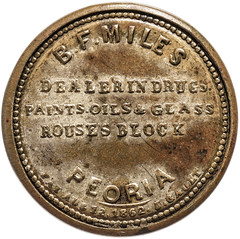 The Dunham collection was auctioned in 1941 by B. Max Mehl and was, up to that time, the finest collection ever formed with 163 recognized varieties. Dunham’s collection was acquired in its entirety by F.C.C. Boyd. In turn, numismatic dealer, John J. Ford acquired Boyd’s collection and when Ford’s collection was sold by Stacks in 2004 it comprised 197 different pieces. Other significant collections include those of the T. James Clarke collection in 1956, the Josiah K. Lilly collection, sold by Robert A. Siegel in 1967, the Arnold Perl collection, sold by Stacks in December 1969, the Donald Kagin collection (150 different varieties), sold intact in 1983 and then resold in the “Abby” sale by Kagin’s Numismatic Auctions in February 1988. 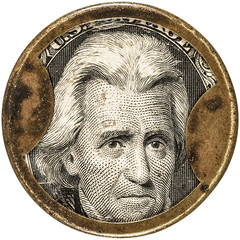 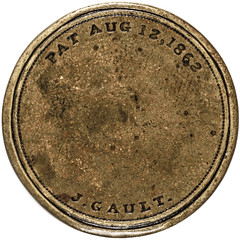 Frederick Mayer, purchased pretty much every variety he did not acquire from the Kagin and Ford collections and when his collection was sold by Currency Auctions of America (owned by Heritage) in 2007 it contained 205 different varieties, the most complete ever assembled. The Michigan Collection contains 147 different varieties and represents many of the finest single specimens that could be obtained for each denomination and from every merchant. A complete variety set (238 pieces) has never been formed, and most likely never will be. Yet, many “complete” sets within the broader “full” sets are within the grasp of the determined numismatist. Encased postage may be collected by denomination, by merchant, by type of merchant (medicinal, dry goods, etc.), by locality of merchant or whatever way one chooses. I greatly enjoyed my quest to assemble a merchant set of encased postage stamps. I never acquired the great rarities like Clafin or Miles, but did own a number of quite scarce
pieces, including a Sands' Ale. A large sale of EPS like this is a perfect opportunity to document a great collection, and it's a superb opportunity for buyers as well. Collectors have a
chance to obtain rarities seen only once in a generation, and dealers can load up on eye-catching stock for the future. Good luck, bidders! -Editor
For more information, or to bid, see:  Wayne Homren, Editor The Numismatic Bibliomania Society is a non-profit organization promoting numismatic literature. See our web site at coinbooks.org. To submit items for publication in The E-Sylum, write to the Editor at this address: whomren@gmail.com To subscribe go to: https://my.binhost.com/lists/listinfo/esylum All Rights Reserved. NBS Home Page Contact the NBS webmaster 
|